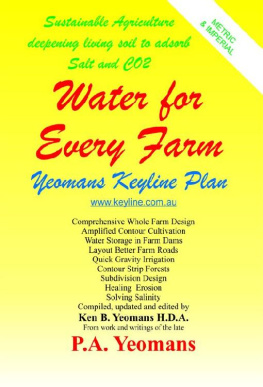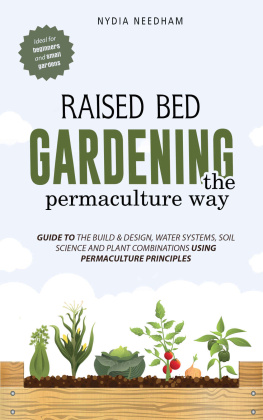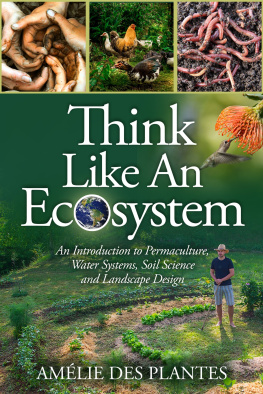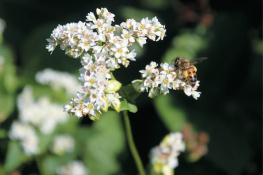

Water for Every Farm - Yeomans Keyline Plan
Much of the material in this book was first published by the editors late father P.A. Yeomans in 1954 (The Keyline Plan), 1958 (The Challenge of Landscape), 1964 (Water for Every Farm), 1968 (Water for Every Farm 2nd Ed), 1971 (The City Forest). See the editors preface for details.
ISBN 1438225784 and EAN-13 9781438225784
Previous editions ISBN 9781-0-646-41875-9
The 1993 edition of this book was printed and bound in Australia by
Griffin Press Pty Limited.
262 Marion Road, Netley,
South Australia 5037
First editions ISBN 0 646 12954 6
E-Book ISBN: 978-0-9808411-0-7
All rights reserved. The contents of this book is
copyright. Apart from any fair dealing for the purpose of
private study, research, criticism or review as permitted
under the Copyright Act, no part of this publication may
be reproduced, stored in a retrieval system, or
transmitted, in any form, or by any means, electronic,
mechanical, photocopying, recording, or otherwise,
without written permission of the copyright owner.
Published by:
Keyline Designs
P.O. Box 3289
Australia Fair Southport, Queensland, 4215
AUSTRALIA.
Phone (07) 5591 6281 Mobile: 0418 745 120
International Tel: +61 7 5591 6281
Email: info@keyline.com.au
Internet: http://www.keyline.com.au
Copyright this edition
Ken Yeomans 1993, 2002, 2003, 2008
Keyline is a Registered Trade Mark
Keyline Designs is a Registered Business Name of
Ken B. Yeomans.
CONTENTS
CONTENTS IN DETAIL
NOTE: In the digital edition of this book the items in the headings list below are all active links to corresponding sections in the document. Order online: www.keyline.com.au/form03.htm
The Keyline Plan was published by Yeomans in 1954. This book became an agricultural best seller and sold out. It is still sought by collectors. Another edition was called for but it was obvious that as the concept had developed and a new book was needed.
The Challenge Of Landscape was published in 1958, in this Yeomans further developed his theories and practice of land development. The Keyline Scale of Permanence was first detailed in this book and provided a practical guide to property planning priorities. The use of Keyline pattern cultivation to enable the successful flood irrigation of undulating land from farm dams was shown.
Water For Every Farm was first published by The K. G. Murray Publishing Company Pty Ltd, Sydney, N.S.W. in December 1965. The second edition was published in October 1968. In this book Yeomans, among other things, detailed the application of Keyline to flat land irrigation and further developed the techniques of irrigating undulating land. The flood irrigation of flat land at a rate of 8 hectares (20 acres) per hour with one-man control was shown to be eminently practical. This book explained many aspects of the plan: economic dam construction; locating farm dams; irrigation channel and steering bank construction; irrigated pasture management; fencing for maximum pasture utilisation; soil improvement and more.
The City Forest was published in 1971 as a paper back. This book extended the logical application of Keyline into urban design and proposed the use of effluent on Keyline planned and irrigated rain forests - city forests. It was used as a text book for many students studying Landscape Architecture in Sydney.
Water For Every Farm Using The Keyline Plan was published by Murray books in 1978. This book was a compilation of the two earlier books named in the title. The compiled edition suffered some weaknesses: firstly it was only in metric, making it difficult to imagine for many readers and to make matters worse on occasions it was inaccurately converted to metric; secondly, in Part 1, the inaccurate idea that a Keyline forms a continuous line right across the landscape, called a common Keyline, was re-presented after non-use for thirty years. This point was somewhat clarified in Part 2 of the book, but these problems contributed to confusion for those going it alone with Keyline planning. This confusion was perhaps compounded by a few errors in metric conversion. In one case, referring to the once only application rate of pre-mixed superphosphate and lime fertiliser, the imperial measurement of 1 cwt per acre of fertiliser became, in metric, 1 kg per hectare, whereas it should have been about 125 kg per ha. Since 1981 Second Back Row Press Pty., Ltd., have twice republished this edition in paperback form. The cover is a beige colour.
Title of a paper presented by P. A. Yeomans to the Habitat Forum of the United Nations Conference on Human Settlements, Vancouver, Canada in 1976.
This Australian Keyline Plan submission to the United Nations Conference was with the sponsorship of the Murray Valley Development League.

by Allan J. Yeomans
Percival Alfred Yeomans (P.A.) was born in Harden N.S.W. in 1905, eldest son of a family of four. In 1928 he married Rita Irene May Barnes, also of Harden. They had three children; Neville born in 1928, Allan in 1931 and Ken in 1947. Rita Yeomans died 1964 and the two original Keyline properties at North Richmond N.S.W. were sold to pay death duties.
P. A. Yeomans married Jane Radek in 1966 and they had two daughters, Julie and Wendy.
Following this marriage he undertook the design and construction of a different concept in cultivation equipment. He solved the need for better equipment than the chisel plow to deeply loosen soil without bringing up the subsoil. This equipment was the first rigid tyned vibrating sub-soil cultivating ripper for use with farm tractors. It is many times more efficient than a chisel plow, and is able to loosen more soil to a greater depth using less tractor power.
The Prince Philip Design Award officially recognised the breakthrough success of this equipment in 1974 when P. A. Yeomans Pty Ltd received this coveted award for the Bunyip Slipper Imp with Shakaerator.
Manufacture of the Bunyip Slipper Imp eventually passed from P. A. Yeomans Pty Ltd to the Yeomans Plow Company, which is now based in South-east Queensland. This company is owned and directed by Allan J. Yeomans the second son of P. A. Yeomans. The equipment has undergone further developed including some landmark design breakthroughs and has been renamed the Yeomans Keyline Plow.
P. A. Yeomans devoted much of his latter life time to consulting, advising and lecturing on Keyline planning for which he has received requests from many parts of the world.
P. A. Yeomans passed away, aged 79 years, in November 1984.
Percival Alfred Yeomans or P.A. as he became known to all alike, changed Australian agriculture. It is doubtful that any man in this countrys history has had such a profound influence on the thinking and methods used by the Australian agricultural community.
He was from the country, but grew up in a town. His father, James Yeomans was a train driver, and close friend of our World War Two Prime Minister, Ben Chifley.
When P.A. started farming he had already achieved considerable success in business. He applied the same thoughtful and common sense approach to agriculture that had proven so successful in his other ventures. He knew what Australian agriculture needed. He created a sustainable agricultural system before the term was even coined. A permanent agriculture, he believed, must materially benefit the farmer, it must benefit the land and it must benefit the soil.
Next page










